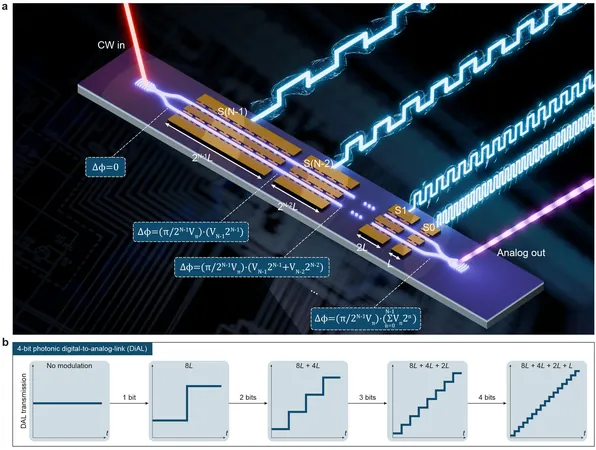
Revolutionizing Fiber-Optic Networks: A Game-Changing Device Transforms Digital to Analog in a Flash!
2025-08-25
Author: John Tan
In a groundbreaking development set to shake up the realm of photonic computing, researchers from the Harvard John A. Paulson School of Engineering and Applied Sciences (SEAS) have unveiled a revolutionary device that effortlessly converts digital electronic signals into analog light signals—streamlining a process that has long been bogged down by inefficiency.
Crafted from lithium niobate—a key material in optoelectronics—this innovative device could be the answer to replacing traditional, energy-hungry digital-to-analog converters that dominate today’s high-speed data networks.
According to senior author Marko Lončar, the Tiantsai Lin Professor of Electrical Engineering at SEAS, "The exchange of massive data flows between electrical storage and computational systems and their optical counterparts is crucial for the future of optical communication and high-performance computing, including advancements like large language models." He emphasizes the need for faster, energy-efficient connections between these domains.
Breaking Down the Bottlenecks in Photonic Computing
Currently, digital-to-analog converters and electro-optic modulators form a cumbersome, often inefficient chain required to transform digital signals into usable analog forms for data centers. This complex system can drain energy and resources, hampering the potential benefits of photonic technologies.
"The energy savings and speed gains from using light are often neutralized by the heavy, expensive electronic equipment needed to create meaningful waveforms like sine or square waves," explains co-first author Yunxiang Song, a graduate student in the Lončar Lab.
"This setup presents a significant bottleneck in various photonic computing applications. Our challenge was to engineer a novel photonic modulator to eliminate the need for those cumbersome digital-to-analog converters."
Unlocking Incredible Speeds and Versatility
The newly developed device accomplishes exactly that, achieving mind-blowing information rates of up to 186 gigabits per second—far exceeding typical home internet speeds. Besides enhancing fiber-optic data transmission, its potential expands into microwave photonics, enhancing wireless communications and radar technology by facilitating the conversion of optical signals to electronic radio frequency signals.
Utilizing photons for computing opens up exciting possibilities, especially since they can process data more efficiently than electrons, allowing for parallel computation.
A Milestone for AI and Beyond
This device has transformative implications for artificial intelligence technologies, as echoed by co-first author Yaowen Hu, who highlights its potential to solve current limitations in computing and data interconnects.
Demonstrating Cutting-Edge Technology
To validate the effectiveness of their device, the team tested it by optically encoding images from the renowned MNIST dataset—a standard benchmark for photonic computing systems. They utilized a cutting-edge lithium niobate manufacturing process developed by the Harvard startup HyperLight Corporation, mimicking the streamlined production methods used for silicon chips that have powered the digital age.
With this development, researchers not only proved the device's capabilities but also highlighted its potential for mass production at lower costs, paving the way for a new era of photonic technologies that could seamlessly integrate with existing silicon photonics.


 Brasil (PT)
Brasil (PT)
 Canada (EN)
Canada (EN)
 Chile (ES)
Chile (ES)
 Česko (CS)
Česko (CS)
 대한민국 (KO)
대한민국 (KO)
 España (ES)
España (ES)
 France (FR)
France (FR)
 Hong Kong (EN)
Hong Kong (EN)
 Italia (IT)
Italia (IT)
 日本 (JA)
日本 (JA)
 Magyarország (HU)
Magyarország (HU)
 Norge (NO)
Norge (NO)
 Polska (PL)
Polska (PL)
 Schweiz (DE)
Schweiz (DE)
 Singapore (EN)
Singapore (EN)
 Sverige (SV)
Sverige (SV)
 Suomi (FI)
Suomi (FI)
 Türkiye (TR)
Türkiye (TR)
 الإمارات العربية المتحدة (AR)
الإمارات العربية المتحدة (AR)